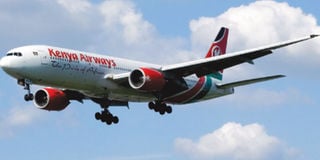Expect a new-look Kenya Airways after Covid-19

Kenya Airways budget carrier Jambojet is yet to take to the skies even after getting the greenlight from the authorities. PHOTO | FILE.
What you need to know:
- The government shall acquire 100 per cent of Kenya Airways, its assets, liabilities, rights, legal cases, licenses, and employees.
- That will, however, not guarantee immediate profitability because with the current flight shutdown, this will be a year of record losses for airlines across the world
- Much as the 2008 global financial crisis put an end to flights of the supersonic Concorde, this pandemic is likely to remove two planes from the skies, that are favourites of passengers across the world
- Michael Joseph said that when the airline resumes flying in Kenya, it will be in a slimmed-down schedule, with fewer destinations and flights.
The next chapter of the Kenya Airways (KQ) journey now seems to be set. In his comments to shareholders during the company’s 44th Annual General Meeting last Friday, that was held virtually, Chairman Michael Joseph mentioned that the National Aviation Management bill had been introduced in Kenya’s Parliament.
The bill arose out of an investment proposal by KQ in which it had sought to take over management of its main base, the Jomo Kenyatta International Airport, from the Kenya Airports Authority. This raised a hue and cry when Parliament reviewed the proposal during a public participation phase, and when its Transportation Committee completed a report in June 2019, it instead recommended re-nationalising the airline that was privatised through an IPO in 1996.
The bill creates a Kenya Aviation Corporation that will promote the development of the aviation sector and advise the government. It will have subsidiaries including an Aviation Investment Corporation, an Aviation Corporation Fund, National Aviation Council, a new Kenya Airports Authority, and a new Kenya Airways, that replaces Kenya Airways PLC which is listed on the Nairobi Securities Exchange.
The government shall acquire 100 per cent of Kenya Airways, its assets, liabilities, rights, legal cases, licenses, and employees. It is expected that minority shareholders, who were already diluted in a restructuring in 2017 will be bought out for a sum of about Sh800 million, while local commercial banks who became shareholders in the restructuring will be issued with Treasury bonds. The airline’s balance sheet will be combined with that of the Kenya Airports Authority.
This will put an end to quarterly disclosures, short-term targets, and the pressure to pay dividends to investors that had become a burden to Kenya Airways. Two months before the beginning of each financial year, KQ and the other entities will submit their revenue, expenditure and funding proposals to the corporation. The accounts of the corporation and its entities shall be reviewed by the Auditor-General.
RECORD LOSSES
But KQ, and the entire airline industry, first has to get past the coronavirus. With the current flight shutdown, and the expected greatly-reduced demand for passengers to fly and visit other countries after the pandemic, this will be a year of record losses for airlines across the world, resulting in fleet cutbacks, staff layoffs and bankruptcies.
Much as the 2008 global financial crisis put an end to flights of the supersonic Concorde, this pandemic is likely to remove two planes from the skies, that are favourites of passengers across the world, but whose economic performance is out of sync with the airlines that operate them. These are the Boeing 747 and the Airbus A380.
Airlines are all turning to their governments in different ways and If KQ was not already on this path to nationalisation, the alternative would have been more drastic. The model taken by the government for KQ is similar to Ethiopia, which formed a similar aviation hub company in 2017 that includes Ethiopian Airlines at the centre. It has been tough to compare the two airlines, but when you look at Ethiopian Airlines numbers, three operating costs that are significantly lower are their wage bill, maintenance and fleet ownership.
Michael Joseph said that when the airline resumes flying in Kenya, it will be in a slimmed-down schedule, with fewer destinations and flights, and the KQ board is also considering which aircraft to reduce to save costs and become more efficient.
With global aviation not expected to recover till after 2021, Kenya Airways has an extra bump on the horizon in 2022 when Kenya hold its general elections, which, going by past evidence, may result in slower investments, economic activity and reduced travel into the country.
Twitter: @bankelele



